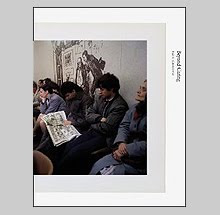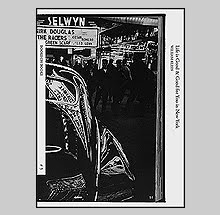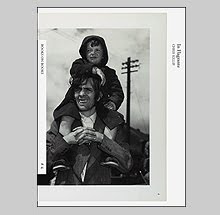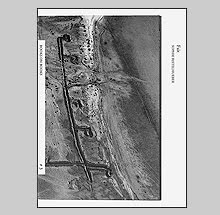
Few bodies of work deserve three different book incarnations. In 1968 Paul Fusco was on the train that transported Robert Kennedy's body from New York to Arlington cemetery. For over seven hours, he made thousands of photographs of the Americans that flocked to pay their respects as the train went slowly by.
From his moving and somewhat limited vantage point, Fusco created a body of work that day that appears even conceptual when compared to his normal practice of the documentary traditions involving assembling "stories." His frames, perhaps guided by instinct more than ever before due to the nature of his fleeting subjects, pose interesting quires into photographic description. Example being, the question of how small a detail can be in a photograph and still carry the full weight of the frame. Many of Fusco's "funeral train" photographs are repetitive in essence but each is filled with the subtle gesture and body language that, even when perceived from afar, conveys so much meaning.
Fusco's remarkable feat was to make so many images that can sit alongside one another even when they appear similar. The arrangements of bodies alongside the train tracks for the formally minded never ceases to excite. By not shooting with super fast shutter speeds as might be expected to freeze movement, Fusco's combination of speed and panning the camera -- locking onto subjects as they pass by -- dictates an fine mix of sharpness and blur. By the end of the day, the crowds dissolve into a swirl of purple blue as the train arrives at its final destination.
The first time this work was published in book form was 30 years after their making. To accompany an exhibition at The Photographers' Gallery in London an edition of print-on-demand books was created using a Xerox DocuColor 100 Digital Color Press. The entire intended edition of 350 copies with nine different covers was never full realized (two hundred were actually printed) but RFK Funeral Train would finally existed for a wider audience.
The quality of the printing and construction of "perfect" binding (which is never perfect) is a bit sketchy. The technologies have a limited capacity of rendering all of the colors and the darker tonalities disappear completely. That being said, it is these faulty characteristics that make this the most touching of the three books published on this work. The flawed and almost improvised handmade feel suits the sense of an immediate response to a moment and the emotion witnessed.

In 2000, the second edition of RFK Funeral Train was published through more traditional print technologies by Umbrage Editions and Magnum Photos. This edition followed the original only in the most basic ways. The photos face pages of black and the typography was the same but the trim size was enlarged by an inch in height and an inch and a half in length. In the original, the photos appeared bleed on the page and this new edition they were surrounded by a bit of black margin. The edit and sequencing is different and most notably, the printing improved greatly.
This was the edition where I first experienced this work and only in retrospect after seeing a friend's copy of the original would I prefer that first Xerox edition. That said, the Umbrage edition is elegant and serves the work beautifully.

This year Aperture has released the third book version called simply RFK.
RFK has been published to coincide with the fortieth anniversary of Robert Kennedy's assassination. This version is not another rehashing of the same images from the first two books but a completely new edit that benefits from a discovery of slides from the LOOK magazine collection at the Library of Congress. RFK includes more than seventy unpublished images as well as photographs Fusco made around New York's St. Patrick's Catherdral and the night-time burial in Arlington National Cemetery.
The most notable difference besides the name change is the size and density of this new edition. With an expanded trim size to 9.5 x 12 and at a solid inch thick, this project has blown up into a full size coffee-table book. There is even an additional text by Vicky Goldberg aside the essays by Norman Mailer, Evan Thomas and Senator Edward Kennedy that appeared in the Umbrage edition.
The justification for doing this new edition after the discovery of the wealth of material in the LOOK magazine collection is understandable but in my opinion, the inclusion of the non-train photographs from the viewing in St. Patrick's and the interment in Arlington dilute the work as it stood in the first versions. The tightness of the book is now broken into three sections -- the viewing and interment photographs are not substantial enough to act as any more than bookends to the real outpouring of emotion found along the train tracks. The photos in those two sections aren't bad (the night-time burial images are wonderfully made) but they do not seem necessary and they aren't -- the first books proved that.
The real payoff in RFK is with the additional trackside images. There are so many wonderful and varied photographs that didn't make it into the first versions that it was necessary for a third visitation to the work. The most impressive of which has Fusco describing tiny figures lining overpasses and on distant baseball fields frozen in a communal moment of reflection where the stillness and the slightest of body language speaks volumes.
Jack Newfield, an acquaintance of Kennedy's, wrote of the time: We are the first generation that learned from experience, in our innocent twenties, that things were not really getting better, that we shall not overcome. We felt, by the time we reached thirty, that we had already glimpsed the most compassionate leaders our nation could produce, and they had been assassinated. And from this time forward, things would get worse; our best political leaders were part of memory now, not hope.
What Fusco documented alongside those rail tracks was sadness that would lead to frustration, and eventually to the extreme cynicism felt towards leadership today. This remarkable document holds that cynicism at bay -- if for just a few precious moments.
Note: Composites do not reflect actual tonal values of each book's printing quality.
Book Available Here (RFK)





























